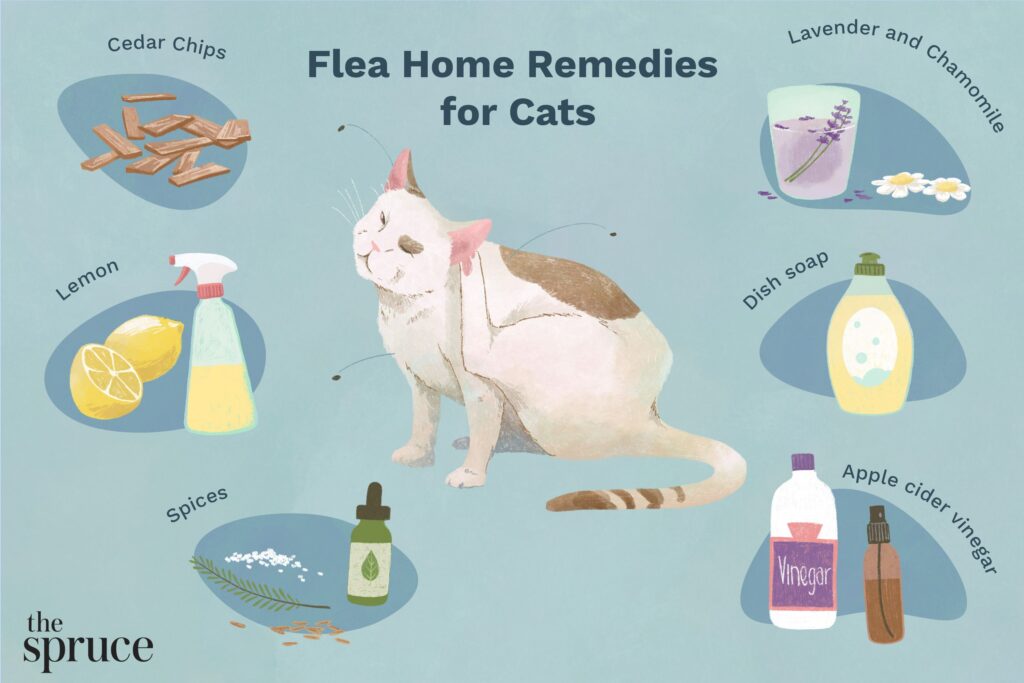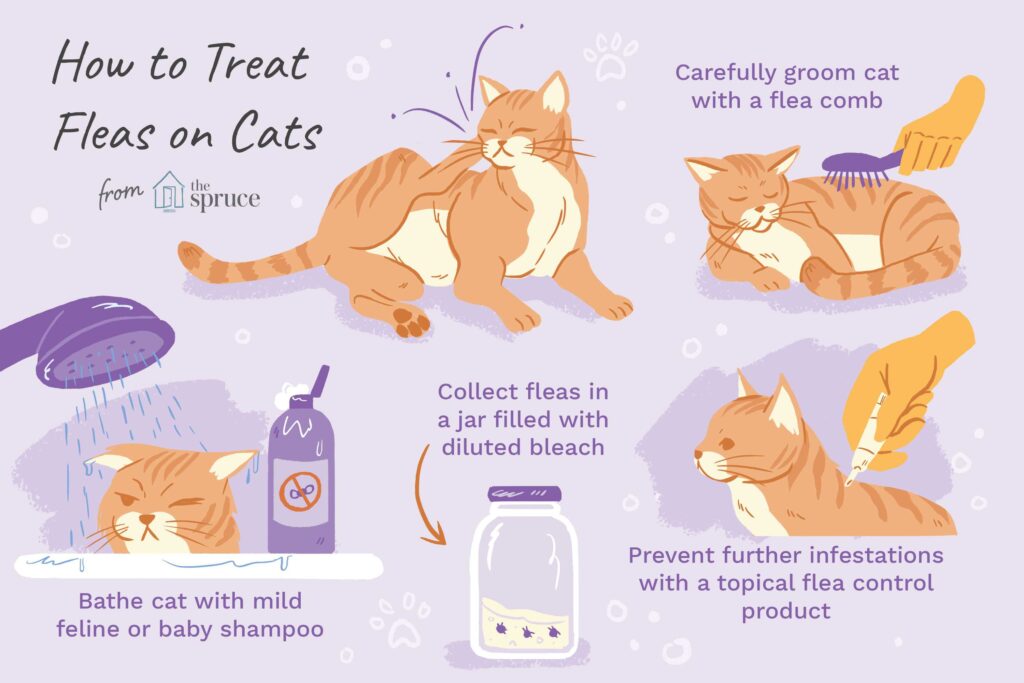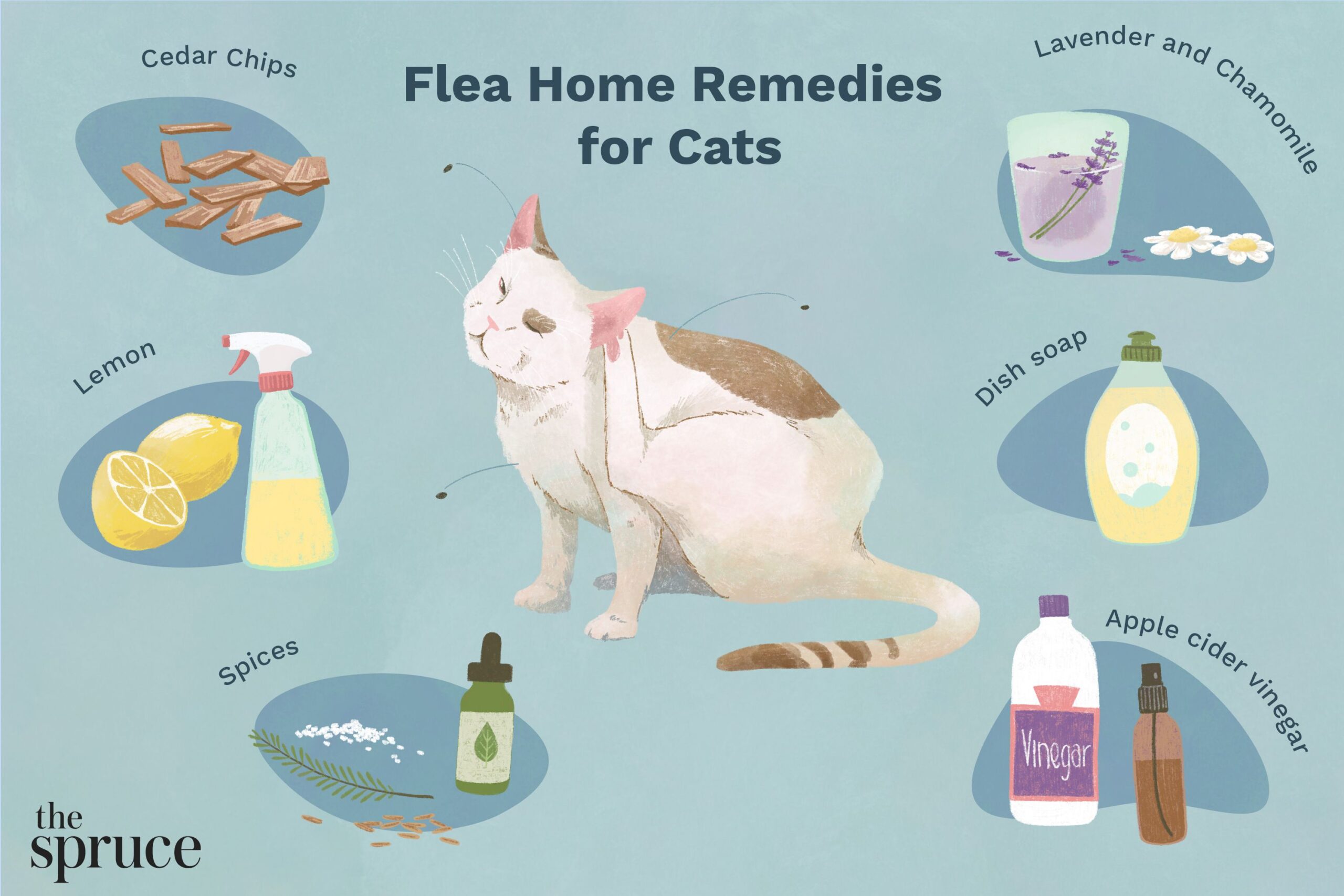If you’re a cat owner, you know how unpleasant and frustrating it can be when your furry friend is plagued by fleas. These tiny pests not only irritate your cat but can also infest your home. However, fret not! This article will provide you with practical and effective tips on how to get rid of fleas on cats. Follow these steps to ensure a happy, flea-free feline companion and a harmonious household.

Understanding the Flea Infestation
Fleas are a common problem faced by many cat owners. These tiny, blood-sucking insects can cause discomfort, itching, and even lead to serious health issues for your furry friend. In order to effectively combat flea infestations, it is important to first understand the signs of an infestation.
Identifying signs of flea infestation
The first step in addressing a flea infestation is to identify the signs. Keep an eye out for excessive itching, scratching, and grooming in your cat. Fleas are agile creatures, so you may also notice them jumping and moving on your cat’s fur. Another key indicator is the presence of small, black specks on your cat’s skin or bedding. These specks are actually flea feces, which contain digested blood and can be a clear indication of an infestation.
Understanding the life cycle of fleas
To effectively combat fleas, it is crucial to understand their life cycle. Fleas have four stages: egg, larva, pupa, and adult. Adult female fleas lay eggs on their host, which then fall off and contaminate the environment. The eggs hatch into larvae, which feed on organic matter before maturing into pupae. Pupae then develop into adult fleas, which reinfest the host and restart the life cycle. This life cycle can take anywhere from a few weeks to several months, depending on environmental conditions.
Potential health risks of fleas on cats
Fleas not only cause discomfort and itching for your cat but can also pose serious health risks. Flea bites can lead to allergic reactions, causing your cat to develop itchy, inflamed, and irritated skin. In some cases, cats can also develop a condition known as flea allergy dermatitis, which can cause intense itching and hair loss. Fleas are also known carriers of diseases like Bartonella and tapeworms, which can further compromise your cat’s health if left untreated.
Implications of flea infestation for your home
Fleas not only affect your cat’s well-being but can also infest your home. Flea eggs, larvae, and pupae can hide in carpets, furniture, and bedding, making it challenging to completely eliminate an infestation. If left unchecked, fleas can multiply rapidly, making it crucial to address the infestation promptly. Failure to do so can result in continued discomfort for your cat and potential reinfestation.
Immediate Relief for Cats
When faced with a flea infestation, providing immediate relief for your cat is essential for their well-being and comfort. Here are a few methods you can try to alleviate their discomfort.
Using a flea comb for removal
A flea comb is a helpful tool in physically removing fleas from your cat’s fur. The fine teeth of the comb can trap fleas, allowing you to easily remove them. Be sure to comb in the direction of hair growth and focus on areas where fleas are commonly found, such as the neck, tail base, and underbelly. Remember to have a bowl of soapy water nearby to drown any fleas you remove.
Providing a warm bath with dish soap
Giving your cat a warm bath with dish soap can help drown and remove fleas from their fur. Dish soap is effective in killing fleas due to its ability to break down their exoskeletons. However, it is important to note that cats are not fond of water, so it’s crucial to approach the bathing process with care and ensure their safety throughout.
Ensuring proper hydration and nutrition to boost their immune system
A strong immune system is crucial for your cat’s ability to combat flea infestations. Providing them with a balanced diet and ensuring they have access to fresh water can help boost their overall health and strengthen their immune system. Consult with a veterinarian to ensure you are providing your cat with the necessary nutrients to ward off fleas and stay healthy.
Usage of Flea Treatments
In addition to immediate relief methods, there are various flea treatments available that can effectively eliminate fleas and prevent future infestations.
Topical flea treatments and their application
Topical flea treatments, such as spot-on treatments, are commonly used to combat fleas. These treatments are typically applied to the back of your cat’s neck or between their shoulder blades, where they cannot lick it off. The treatment then spreads through the oil glands in their skin, effectively killing fleas on contact. It is important to follow the instructions provided by the manufacturer for proper application and dosage.
Oral flea treatments and their usage
Oral flea treatments are another option for eliminating fleas. These treatments come in the form of tablets or chewables and are ingested by your cat. Once consumed, the medication circulates in their bloodstream, killing fleas when they bite. Oral flea treatments are often favored by cat owners as they eliminate the need for topical application and provide comprehensive protection.
Understanding potential side effects of flea treatments
While flea treatments are generally safe and effective, it is important to be aware of potential side effects. Some cats may experience mild side effects such as skin irritation or digestive upset after treatment. In rare cases, more severe reactions can occur, including allergic reactions. It is important to closely monitor your cat after administering any flea treatment and consult with your veterinarian if you notice any concerning symptoms.
Precautions while using flea treatments
When using flea treatments, it is crucial to read and follow the instructions provided. Different treatments have different guidelines, including appropriate dosage based on your cat’s weight and age. It is important to never use flea treatments intended for dogs on cats, as they can contain ingredients that are toxic to felines. Additionally, if you have multiple pets, ensure that the flea treatment you choose is safe for all of them to avoid any accidental harm.
Choosing Safe Flea Treatments for Kittens
Kittens require special care when it comes to flea treatments due to their delicate immune systems and developing bodies. It is essential to choose safe and age-appropriate flea treatments for these little ones.
Consideration of kittens’ age and health status
When selecting a flea treatment for kittens, it is vital to consider their age and health status. Some flea treatments are not suitable for very young kittens, as their bodies may not be able to tolerate certain chemicals. It is recommended to consult with a veterinarian who can guide you in selecting the most appropriate treatment based on the age and health of your kittens.
Preventing contact with toxic substances
Kittens are prone to exploring their surroundings and may come into contact with toxic substances if unsupervised. It is important to choose flea treatments that are specifically formulated for kittens and avoid using any products intended for adult cats. Always read the labels carefully and ensure the product is safe for use on kittens before applying or administering.
Specialized flea treatments for kittens
There are flea treatments on the market specifically formulated for kittens. These treatments often come in liquid or powder form and may have lower concentrations of active ingredients to ensure the safety of young felines. Using specialized flea treatments specifically designed for kittens can help eliminate fleas while minimizing the risk of adverse effects.
Natural Remedies to Get Rid of Fleas
For those who prefer a more natural approach, there are several home remedies and natural alternatives that can help in the battle against fleas.
Using essential oils for flea control
Some essential oils such as lavender, eucalyptus, and cedarwood have flea-repellent properties. Diluting a few drops of these oils in water and spraying the mixture on your cat’s bedding or around their living area may help deter fleas. However, it is crucial to use essential oils with caution, as some can be toxic to cats. Always consult with a veterinarian before using essential oils on your cat.
Utilizing diatomaceous earth
Diatomaceous earth (DE) is a natural substance made from fossilized algae. When sprinkled in areas where fleas may be present, such as carpets or bedding, DE can dehydrate and kill fleas and their eggs. It is important to use food-grade DE and follow the instructions carefully to avoid inhalation and irritation. Keep your cats away from the treated areas until the dust settles.
Employing homemade flea sprays
Homemade flea sprays can be made using ingredients like apple cider vinegar, lemon juice, or rosemary. Mixing these ingredients with water and spraying the solution on your cat’s fur can help repel fleas. However, it is important to note that natural remedies may not be as potent as conventional treatments and may require more frequent application.
Benefits and risks of natural remedies
Natural remedies can offer an alternative to chemical-based flea treatments, especially for those who prefer a more holistic approach. However, it is important to remember that natural remedies may vary in effectiveness and should be used in conjunction with other preventative measures. Additionally, some natural ingredients can be toxic to cats, so it is crucial to consult with a veterinarian before using any natural remedies.
Keeping Your Cat’s Environment Flea-Free
In order to effectively combat flea infestations, it is important to address not only your cat but also their living environment. Implementing proper hygiene and preventive measures can help keep your cat’s environment flea-free.
Regularly cleaning your cat’s bedding
Fleas and their eggs can hide in your cat’s bedding, so it is important to regularly clean and wash it. Use hot water and detergent to eliminate any fleas, larvae, or eggs that may be lurking. Additionally, vacuuming carpets, upholstery, and any other areas where your cat rests can help remove fleas and their eggs from the environment.
Using flea sprays and powders in your home
Flea sprays and powders specifically formulated for your home can be used to treat areas where fleas may be present. These products often contain insecticides that target fleas and their life stages. Carefully read the instructions and apply the product as directed, paying special attention to areas where your cat spends the most time.
Treating outdoor areas where your cats may roam
Fleas can also be found in outdoor areas where your cats roam, such as gardens or patios. Treating these areas with flea sprays or powders can help eliminate any fleas or larvae present. Additionally, keeping the outdoor environment clean and free of organic debris can help reduce the likelihood of flea infestations.
Preventing future flea infestations
Prevention is key when it comes to dealing with fleas. Regularly grooming your cat, including thorough inspections for fleas, can help detect infestations early on. Investing in preventative measures such as flea collars or spot-on treatments can also provide long-lasting protection against fleas. Additionally, maintaining a clean and hygienic home environment can help minimize the risk of future infestations.

Flea Prevention Techniques
In addition to treating flea infestations, implementing preventative measures can help keep your cat flea-free and minimize the chances of future infestations.
Regular checks and grooming of your cats
Regularly checking and grooming your cats is an important part of flea prevention. Routinely inspecting your cat’s fur for fleas, eggs, or flea dirt can help you catch infestations early. Gently combing their fur with a flea comb can also help remove any fleas or eggs that may be present.
Investing in preventative flea collars or spot-on treatment
Preventative flea collars or spot-on treatments can be an effective long-term solution for preventing fleas. These treatments typically release small amounts of insecticide into your cat’s skin, creating a barrier against fleas. It is important to choose a product that is specifically designed for cats and follow the instructions provided for proper application and duration of protection.
Maintaining cleanliness in your home
Maintaining cleanliness in your home can play a significant role in preventing flea infestations. Vacuuming regularly, especially in areas where your cat spends time, can help remove any fleas or eggs that may be present. Laundering your cat’s bedding and any fabric items they come into contact with can also help eliminate fleas and their life stages.
Consulting with Your Vet
While there are several methods and treatments available for addressing fleas, it is important to consult with a veterinarian for professional guidance.
When to seek professional medical advice
If you are unable to effectively address a flea infestation or if your cat is experiencing severe discomfort or health issues, it is recommended to seek professional medical advice from a veterinarian. They can provide a comprehensive assessment of your cat’s condition and recommend appropriate treatments or interventions.
Discussing long-term flea control measures
A veterinarian can provide valuable insights on long-term flea control measures for your cat. They can help tailor a flea prevention plan based on your cat’s individual needs and recommend the most appropriate treatments or products. Regular check-ups with your veterinarian will also allow them to monitor your cat’s overall health and adjust the flea control plan if needed.
Options for stronger flea treatment, if needed
In some cases, a stronger flea treatment may be required to effectively combat an infestation. Veterinarians have access to a range of prescription-strength flea treatments that may be more potent than over-the-counter options. If your cat’s flea infestation persists despite your efforts, your veterinarian can assess the situation and recommend stronger treatments if necessary.

Understanding Flea Resistance
Flea resistance refers to the ability of fleas to develop a resistance to certain active ingredients in flea treatments. Understanding flea resistance is essential for effective flea control.
Knowing potential signs of flea resistance
It is important to be aware of potential signs of flea resistance to ensure that the chosen treatment remains effective. If you notice that fleas on your cat are not being eliminated or if reinfestations occur shortly after treatment, it may be an indication of flea resistance. Changes in behavior, increased itching, and the presence of flea dirt can also suggest that fleas are becoming resistant to the treatment.
Adjusting treatment plans if resistance arises
If you suspect flea resistance, it is important to consult with your veterinarian. They can assess the situation and recommend alternative treatments or adjust the current treatment plan accordingly. It may be necessary to switch to a different type of flea treatment or combine multiple treatment methods to effectively combat the resistant fleas.
Preventing flea resistance through diversified treatment plans
To prevent flea resistance from occurring, it is recommended to diversify your treatment plans. This can involve rotating different types of flea treatments or using a combination of spot-on treatments, collars, and environmental control methods. By employing varied and targeted approaches, you can reduce the risk of fleas developing resistance to a single treatment method.
FAQs on Fleas in Cats
Here are some frequently asked questions about fleas in cats that can provide further insight and guidance.
Frequency of flea infestations in cats
The frequency of flea infestations in cats can vary depending on a range of factors, including geographical location, lifestyle, and preventative measures taken. Cats that spend time outdoors or have contact with other animals are generally at a higher risk of flea infestations. Regular prevention and hygiene practices can help minimize the frequency of infestations.
Risk of contacting diseases from cat fleas
Fleas can transmit various diseases to cats, including Bartonella, commonly known as cat scratch disease. Fleas are also known carriers of tapeworms, which can infect cats if they ingest fleas during grooming. It is important to address flea infestations promptly to reduce the risk of disease transmission.
Success rate of various flea treatments
The success rate of flea treatments can vary depending on the treatment method, the severity of the infestation, and the individual cat’s response. In general, flea treatments, when used correctly and in combination with preventative measures, can effectively eliminate fleas and prevent reinfestation. However, it is important to note that no treatment guarantees 100% efficacy, and regular monitoring and follow-up treatments may be necessary.
Dealing with recurrent flea infestations
Recurrent flea infestations can be frustrating for cat owners. If you are facing recurrent infestations despite your efforts, it is crucial to reassess your treatment and prevention strategies. Consult with your veterinarian to rule out any underlying issues or challenges that may be contributing to the persistent infestations. They can provide additional guidance and recommend alternative treatment options if necessary.
In conclusion, addressing flea infestations in cats requires a comprehensive approach that includes understanding the signs of infestation, providing immediate relief, utilizing flea treatments, selecting safe options for kittens, exploring natural remedies, maintaining a flea-free environment, implementing prevention techniques, consulting with a veterinarian, understanding flea resistance, and being aware of common concerns and questions. By combining these approaches, you can effectively combat flea infestations and ensure the health and well-being of your feline companion.



